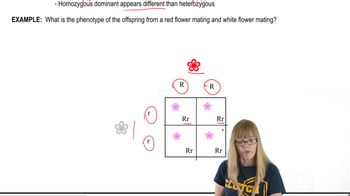Table of contents
- 1. Introduction to Genetics51m
- 2. Mendel's Laws of Inheritance3h 37m
- 3. Extensions to Mendelian Inheritance2h 41m
- 4. Genetic Mapping and Linkage2h 28m
- 5. Genetics of Bacteria and Viruses1h 21m
- 6. Chromosomal Variation1h 48m
- 7. DNA and Chromosome Structure56m
- 8. DNA Replication1h 10m
- 9. Mitosis and Meiosis1h 34m
- 10. Transcription1h 0m
- 11. Translation58m
- 12. Gene Regulation in Prokaryotes1h 19m
- 13. Gene Regulation in Eukaryotes44m
- 14. Genetic Control of Development44m
- 15. Genomes and Genomics1h 50m
- 16. Transposable Elements47m
- 17. Mutation, Repair, and Recombination1h 6m
- 18. Molecular Genetic Tools19m
- 19. Cancer Genetics29m
- 20. Quantitative Genetics1h 26m
- 21. Population Genetics50m
- 22. Evolutionary Genetics29m
3. Extensions to Mendelian Inheritance
Variations of Dominance
Problem 3
Textbook Question
In shorthorn cattle, coat color may be red, white, or roan. Roan is an intermediate phenotype expressed as a mixture of red and white hairs. The following data were obtained from various crosses: How is coat color inherited? What are the genotypes of parents and offspring for each cross?
 Verified step by step guidance
Verified step by step guidance1
<Step 1: Understand the Phenotypes> - In shorthorn cattle, the coat colors are red, white, and roan. Roan is a mixture of red and white hairs, indicating incomplete dominance between the red and white alleles.
<Step 2: Define the Alleles> - Assign alleles to the coat colors: let 'R' represent the red allele and 'W' represent the white allele. Roan, being a mixture, would be represented by the heterozygous genotype 'RW'.
<Step 3: Analyze the Crosses> - For each cross, determine the possible genotypes of the parents based on the phenotypes of the offspring. Use a Punnett square to predict the genotypic and phenotypic ratios of the offspring.
<Step 4: Determine Genotypes of Parents> - If a cross between two roan cattle (RW x RW) results in red, white, and roan offspring, this supports the incomplete dominance model. Analyze other crosses similarly to deduce parental genotypes.
<Step 5: Summarize Inheritance Pattern> - Conclude that coat color in shorthorn cattle is inherited through incomplete dominance, where the heterozygous genotype results in the roan phenotype. Confirm this pattern with the data from the crosses.
Recommended similar problem, with video answer:
 Verified Solution
Verified SolutionThis video solution was recommended by our tutors as helpful for the problem above
Video duration:
2mPlay a video:
Was this helpful?
Key Concepts
Here are the essential concepts you must grasp in order to answer the question correctly.
Inheritance Patterns
Coat color in shorthorn cattle demonstrates a classic example of incomplete dominance, where neither allele is completely dominant over the other. In this case, the red and white alleles produce a roan phenotype when combined, resulting in a blend of traits. Understanding this pattern is crucial for predicting the genotypes and phenotypes of offspring based on parental combinations.
Recommended video:
Guided course

Organelle Inheritance
Genotype and Phenotype
The genotype refers to the genetic makeup of an organism, while the phenotype is the observable expression of that genotype. In shorthorn cattle, the genotypes can be represented as RR (red), WW (white), and RW (roan). Recognizing the relationship between genotype and phenotype is essential for determining the expected outcomes of genetic crosses.
Recommended video:
Guided course

Gamete Genotypes
Punnett Squares
Punnett squares are a tool used to predict the genotypic and phenotypic ratios of offspring from genetic crosses. By organizing the possible gametes from each parent, a Punnett square allows for a visual representation of inheritance patterns. This method is particularly useful in understanding the inheritance of coat color in shorthorn cattle and calculating the likelihood of different phenotypes in the offspring.
Recommended video:
Guided course

Chi Square Analysis

 4:37m
4:37mWatch next
Master Variations on Dominance with a bite sized video explanation from Kylia Goodner
Start learningRelated Videos
Related Practice


